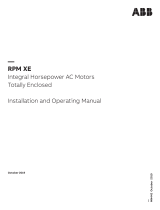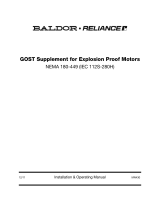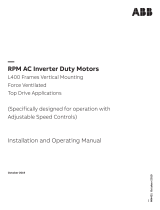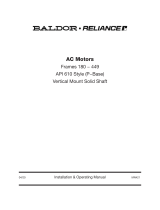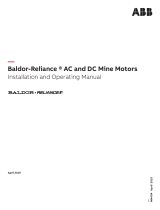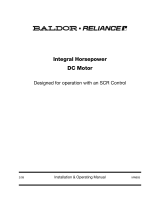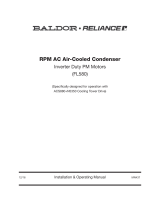Page is loading ...

INSTALLATION,
OPERATION AND CARE
OF INTEGRAL HORSEPOWER
INDUCTION MOTORS
(180 – 5000 FRAMES)
NAVY
A-C MOTORS
‘‘Solutions
You Can
Trust’’
Instruction Manual B-3677-3
June 2008


TABLE OF CONTENTS
RECEIVING AND HANDLING.....................................................................................................................1
ACCEPTANCE.......................................................................................................................................1
UNPACKING..........................................................................................................................................1
STORAGE CONDITIONS – SHORT TERM...........................................................................................1
STORAGE PREPARATION..............................................................................................................2
FOR STORAGE OF EXTENDED PERIOD OF TIME (GREATER THAN 18 MONTHS)........................3
INSTALLATION...........................................................................................................................................4
INSPECTION..........................................................................................................................................4
LOCATION.............................................................................................................................................4
LIFTING MEANS....................................................................................................................................4
MOUNTING............................................................................................................................................4
DRIVEN LOAD.......................................................................................................................................4
COUPLING GUARDS ............................................................................................................................4
DRAIN HOLES.......................................................................................................................................5
ROTATION.............................................................................................................................................5
TEST FOR GENERAL CONDITION.......................................................................................................5
MOTOR DRYING PROCEDURE ...........................................................................................................5
INITIAL LUBRICATION..........................................................................................................................5
OIL LUBRICATED BEARINGS...............................................................................................................5
STARTING .............................................................................................................................................5
OPERATION................................................................................................................................................6
MAINTENANCE...........................................................................................................................................7
DISASSEMBLY......................................................................................................................................7
REMOVING BRACKETS AND ROTOR............................................................................................7
REMOVING AND REPLACING BALL BEARINGS...........................................................................8
REASSEMBLY .................................................................................................................................8
BEARING LUBRICATION (During Operation) .......................................................................................9
RECOMMENDED LUBRICANT........................................................................................................9
CARTRIDGE BEARINGS.................................................................................................................9
LUBRICATION PROCEDURE..........................................................................................................9
OIL LUBRICATED BEARINGS.............................................................................................................10
SERVICE PROGRAMS........................................................................................................................10
RENEWAL PARTS.........................................................................................................................10
Reliance
®
is a registered trademark of Baldor Electric Company or its subsidiaries.
© Baldor Electric Company, 2007.

1
The products described in this manual are manufactured by Baldor Electric Company.
RECEIVING AND HANDLING
ACCEPTANCE
Thoroughly inspect the motor before accepting shipment
from the transportation company. If any of the goods
called for in the bill of lading or express receipt are
damaged or the quantity is short, do not accept them until
the freight or express agent makes an appropriate notation
on your freight receipt or express receipt. If any concealed
loss or damage is discovered later, notify your freight or
express agent at once and request him to make an
inspection.
We will be very happy to assist you in collecting claims for
loss or damage in shipment; however, this willingness on
our part does not remove the transportation company's
responsibility in reimbursing you for collection of claims or
replacement of material.
Claims for loss or damage in shipment must not be
deducted from the invoice, nor should payment of the
invoice be withheld awaiting adjustment of such
claims, as the carrier guarantees safe delivery.
If considerable damage has been incurred and the
situation is urgent, contact your nearest Reliance
®
Sales
Office for assistance. Please keep a written record of all
communications.
UNPACKING
After unpacking and inspection to see that all parts are in
good condition, turn the shaft by hand to be sure there are
no obstructions to free rotation. Equipment which has
been in storage for some-time should be tested and
relubricated prior to being put into service. Refer to "Test
for General Condition" and "Lubrication" for procedure to
be performed after extended storage.
STORAGE CONDITIONS –
SHORT TERM
The following storage requirements must be followed:
1. Motors are to be kept in their original containers or
provided with equivalent protection and stored in a
warehouse free from extremes in temperature,
humidity, and corrosive atmosphere.
2. If unusual vibrations exist at the storage location, the
motor should be protected with isolation pads.
3. All breathers and drains are to be operable while in
storage and/or the moisture drain plugs removed.
The motors must be stored so the drain is at the
lowest point.

2
STORAGE PREPARATION
Improper storage of electric machines will result in
seriously reduced reliability of that equipment. For
example, an electric motor that does not experience
regular usage while being exposed to normally humid
atmospheric conditions is likely to cause the bearings to
rust or rust particles from surrounding surfaces to
contaminate the bearings. The electrical insulation may
absorb an excessive amount of moisture leading to the
motor winding failing to ground. The following preparations
should be followed:
1. Minimize condensation in and around the motor by
use of desiccants or other humidity control methods.
2. Motor space heaters when specified are to be
energized where there is a possibility that the
storage ambient conditions will reach the dew point.
Space heaters are an option.
3. Coat all external machined surfaces with a material
to prevent corrosion. An acceptable product for this
purpose is Exxon Rust Ban #392.
4. Measure and record the electrical resistance of the
winding insulation with a megger or an insulation
resistance meter. Minimum accepted Megohm level
is the insulation kV rating +1 Megohm. If levels fall
below the above, contact the nearest Reliance
®
sales office. The recorded data will be required when
removing from storage.
5. Some motors have a shipping brace attached to the
shaft to prevent damage during transportation. The
shipping brace, if provided, must be removed and
stored for future use. The brace must be reinstalled
to hold the shaft firmly in place against the bearing
before the motor is moved.
6. Upon placing the motor into extended storage
(greater than 3 months), the motors with regreasable
bearings must be greased per Table 1 followed by
the motor shaft being rotated a minimum of 15 times
after greasing. Non-regreasable motors with "Do Not
Lubricate" nameplate should also be rotated 15 times
to redistribute grease within the bearing.
7. Remove the grease drain plug (opposite the grease
fitting) on the bottom of each end bracket prior to
lubricating the motor. Replace the plug after
greasing.
Table 1
Lubrication Volume (Storage)
Frame Size Volume in Cubic Inches
182 thru 215 0.5
254 thru 286 1.0
326 thru 365 1.5
405 thru 449 2.5
5000 (3600 RPM) 1.5
5000 (1800 RPM &
Slower)
2.5
8. Regreasable bearings are to be greased per Table 1
at the time of being placed into extended storage.
Motor shafts are to be rotated 15 revolutions
manually every 3 months and additional grease
added every nine months per Table 1 to each
bearing. Bearings are to be greased at the time of
removal from storage.
Non-regreaseable motors should have their shaft
rotated 15 revolutions every 3 months.
9. All breather drains should be fully operable while in
storage. The motors must be stored so the drain is at
the lowest point. All breathers and automatic "T"
drains must be operable to allow breathing at points
other than through the bearing fits.
10. The space heaters when specified are to be
connected and operable while in storage.
11. Windings are to be meggered at the time equipment
is put in storage. Reference Para. 4 above. At the
time of removal from storage, the insulation
resistance reading must not have dropped more than
50% from the initial reading. Any drop below this
point necessitates electrical or mechanical drying.
Refer to "Motor Drying Procedure."
12. Where motors are not stored in the original
containers, but are removed and mounted on others
pieces of machinery, the mounting must be such that
the drains and breathers and space heaters are fully
operable. In this respect, the drains must be kept at
the lowest point in the motor so that all condensation
can automatically drain out.

3
FOR STORAGE OF
EXTENDED PERIOD OF TIME
(GREATER THAN 18 MONTHS)
All requirements of general preparation and short term
storage apply with the following additional requirements.
1. Motor is to be crated in a box similar to EXPORT
BOXING but that the "shell" (sides & top of box) will
be LAG-BOLTED to the wooden base (not nailed as
export boxes are). This design will allow for the
opening and reclosing the box many times without
destroying the "shell".
2. The motor will be sealed in an airtight vapor barrier
bag with desiccant inside. This airtight bag will give
added protection during shipment of motor to the
permanent storage area.
3. It is recommended after the first "Inspection" for
megger reading, turning the shaft, etc., the vapor bag
be re-sealed by taping it closed with masking or
some similar tape. Also add new desiccant inside
bag before closing. After which place shell over
motor and replace lag bolts.
4. If a "zipper-closing" type bag is used instead of the
"heat-sealed" type bag, then rezipper the bag closed
instead of taping it.
5. Be sure to add new desiccant inside bag after each
periodic inspection.
6. Minimize the accumulation of condensed water in
and around the machine.

4
INSTALLATION
The user must select a motor starter and overcurrent
protection suitable for this motor and its application.
Consult motor starter application data as well as the
National Electric Code and/or other applicable local codes.
INSPECTION
After the motor is unpacked, examine the nameplate data
to see that it agrees with the circuit to which it is to be
connected. The motor is minimally guaranteed to operate
successfully within ± 5% of nameplate frequency and ±
10% of nameplate volts. The sum of the variation from
rated frequency and voltage when expressed as a
percentage, may not exceed 10%.
LOCATION
The motor should be installed in a location compatible with
the motor enclosure and specific ambient.
To allow adequate air flow, the following clearances must
be maintained between the motor and any obstruction:
TEFC – Enclosures
Fan Cover 180-210 Frame 1”
Air Intake 250-320 Frame 1.5”
360-449 Frame 2”
5000 Frame 2.5”
Exhaust Envelope equal to the "P" dimension on
the motor dimension sheet.
Protected Enclosures
Bracket Same as TEFC.
Intake
Frame Exhaust out the sides – envelope a
Exhaust minimum of the "P" dimension plus 2".
Exhaust out the end – same as intake.
LIFTING MEANS
When the motor is installed on a common base, the
eyebolt provided on the motor should not be used to lift
the assembly and base but, rather, the assembly should
be lifted by a sling around the base or by other lifting
means provided on the base.
In all cases, care should be taken to assure lifting in the
direction intended in the design of the lifting means.
Likewise, precautions should be taken to prevent
hazardous overloads due to deceleration, acceleration or
shock forces while handling.
MOUNTING
Mount the motor on a rigid foundation. After carefully
aligning the motor with the driven unit, bolt securely in
place.
DRIVEN LOAD
The coupling used to connect the motor to the driven load
should be positioned on the shaft as close to the shaft
shoulder as possible. If the bore on the coupling hub has
an interference fit with the shaft, heat the coupling before
installing on the shaft. Driving the coupling onto the shaft
will damage the bearings.
Accurate alignment is essential. Secure the motor and the
driven unit rigidly to the base.
COUPLING GUARDS
Providing covers for the rotating parts is essential for the
safety of operating personnel. Covers should be
sufficiently rigid to maintain adequate guarding in all
conditions of service.

5
DRAIN HOLES
When motors have been equipped with a stainless steel T-
drain in each end bracket, these drains are to remain in
place and are not to be removed. The drains are for
drainage of any condensation build up that may occur. Do
not paint the T-drains, or otherwise cover their holes.
ROTATION
To prevent possible damage to the driven equipment
check the motor rotation prior to installing the coupling. If it
becomes necessary to reverse the direction of rotation,
disconnect the motor from the power source and
interchange two of the three line leads.
TEST FOR GENERAL CONDITION
If the motor has been in storage for an extended period or
has been subjected to adverse moisture conditions, the
insulation resistance of the stator winding must be
checked with a megohmeter.
If the insulation resistance is lower than the KV rating +
one megohm, the windings must be dried out as described
below.
MOTOR DRYING PROCEDURE
Motors shall be dried by the following procedure:
Bake motor in an oven at temperatures not exceeding
90°C until insulation resistance becomes constant.
After drying, the motor must be relubricated before placing
in service.
INITIAL LUBRICATION
Reliance motors are shipped from the factory with the
bearings properly packed with grease and ready to
operate. Where the unit has been subjected to extended
storage (3 months or more) the bearings when applicable
should be relubricated per Table 5 prior to starting.
OIL LUBRICATED BEARINGS
The oil reservoirs (if provided) have not been filled with oil
at the time of shipment and it is necessary to fill to the
proper level indicated by the oil gages. See applicable
motor drawing for details on grease or oil lubrication
requirements.
STARTING
When starting the motor, check the following items:
1. The rotor should turn freely when disconnected from
the load.
2. Driven machine should be unloaded when first
starting the motor.
The motor should run smoothly with little noise. If the
motor should fail to start and produces a decided hum, it
may be that the load is too great for the motor or that it
has been connected improperly. Shut down immediately
and investigate for trouble.

6
OPERATION
Due to the inherent characteristics of insulating materials,
abnormally high temperatures shorten the operating life of
electrical apparatus. The total temperature, not the
temperature rise, should be the measure of safe
operation. Aging of insulation occurs at an accelerated
rate at abnormally high temperatures.
Unbalanced voltage or single-phase operation of
polyphase machines may cause excessive heating and
ultimate failure. It requires only a slight unbalance of
voltage applied to a polyphase motor to cause large
unbalanced currents and resultant overheating.
Periodic checks of phase voltage, frequency and power
consumption of a motor while in operation are
recommended; such checks assure the correctness of
frequency and voltage applied to the motor and yield an
indication of the load offered by the apparatus which the
motor drives. Comparisons of this data with previous no-
load and full-load power demands will give an indication of
the performance of the complete machine. Any serious
deviations should be investigated and corrected.
Stator troubles can usually be traced to one of the
following cases.
Damaged insulation Overloading
Operating single-phase Moisture
Oil and dirt
Dust and dirt are usually contributing factors. The effect of
dust on the motor temperature through restriction of
ventilation is a principal reason for keeping the motor
exterior surface clean.
Squirrel-cage rotors are rugged and, in general, give little
trouble. The first symptom of a defective rotor is lack of
torque. This may cause a slowing down in speed
accompanied by growling noise or perhaps failure to start
the load. This is caused by an open or high resistance
joint in the rotor bar circuit.

7
MAINTENANCE
The fundamental principle of electrical maintenance is
KEEP THE APPARATUS CLEAN AND DRY. This
requires periodic inspection of the motor, the frequency
depending upon the type of motor and the service.
The following items should be checked at regular intervals:
1. Assembly screws, bolts and nuts should be tight.
They may loosen if motor is not securely bolted and
tends to vibrate.
2. Insulation resistance of motors in service should be
checked periodically at approximately the same
temperature and humidity conditions to determine
possible deterioration of the insulation. When such
measurements at regular intervals indicate a wide
variation, the cause should be determined.
3. Enclosed motors require very little attention. Be sure
that external air chamber of fan-cooled motors does
not become clogged with foreign material which will
restrict passage of air.
4. Face seal oil reservoirs when provided, must be
maintained at proper level.
DISASSEMBLY
If it becomes necessary to disassemble the motor, care
should be taken not to damage the stator windings.
Precautions to keep bearings clean should be exercised.
Before removing either end shield:
1. Turn off and lock out or tag power to the motor.
2. Disconnect motor leads. Tag the leads to insure
proper reconnection.
3. Remove motor from mounting base.
4. Mark end brackets and outer caps if provided,
relative to position so they can be easily replaced.
REMOVING BRACKETS AND ROTOR
4. On TEFC motors remove the fan cover and fan.
5. When provided remove the outer caps.
6. Remove the inner cap(s) screws or nuts.
7. Remove the brackets. The rotating assembly (shaft,
rotor, bearings) should be supported so it does not
drop when the brackets are removed.
8. Remove the rotating assembly using extreme care to
avoid damaging the motor windings.
Table 2
Bearing Locknut Torques
Bore Code
Locknut Torque
(foot-pounds)
00 10–20
01 10–20
02 10–20
03 10–20
04 12–35
05 23–50
06 32–60
07 39–70
08 50–80
09 64–90
10 67–100
11 82–125
12 99–150
13 131–175
14 152–200
15 173–250
16 197–275
17 222–325
18 248–375
19 277–425
20 345–475
21 380–550
22 380–550
24 380–550
26 380–550
32 380–550
Reference MIL-B-17931E

8
REMOVING AND
REPLACING BALL BEARINGS
Bearings should not be removed unless they are to be
replaced. When removal is necessary, use a bearing
puller. Refer to Motor Drawing for recommended bearing
puller.
All bearings must be replaced with the identical part used
by Reliance. In many cases special bearings are used
which cannot be identified by markings on the bearing.
Refer to Motor Drawing for bearing part number.
To install a bearing, heat the bearing in an oven at 250°F
for 1 hour. This will expand the inner race, allowing it to
slip over the bearing seat.
For MIL-STD-740 Quiet Service Motors, bearings shall be
heated in a thermostatically controlled heating oven in
preparation for mounting. Heat for 1 hour at 203 ± 10°F.
Install bearing locknuts while bearings are hot, torquing to
the values given in table 2. Allow bearing to cool to room
temperature, loosen locknut and retorque to the values of
table 2.
The majority of bearings used now have a C3 internal
clearance.
REASSEMBLY
1. Apply the correct type of grease per DOD-G-24508
as shown in Figure 1 to each bracket, bearing and
inner cap. Taking care to see that the bearing ball
cage is packed with grease. If the motor has inlet
grease pipes, fill them with grease.
2. Follow reverse procedure as outlined for
Disassembly. Replace brackets and outer caps (if
required) in their original position.
3. Rotate the motor shaft by hand at least 3 revolutions
to make sure there is no binding or drag and the
rotor shaft assembly turns freely.

9
BEARING LUBRICATION
(During Operation)
This motor has been properly lubricated at the time of
manufacture and it is not necessary to lubricate at time of
installation. When the motor has been in storage for a
period of 3 months or more, regreaseable bearings should
be lubricated before starting.
Lubrication of anti-friction bearings should be done as a
part of a planned maintenance schedule. The Recomm-
ended Lubrication interval should be used as a guide to
establish this schedule. Infrequently used motors
(operating less than 3 months) shall be maintained per
Extended Storage Requirements. Over greasing is a major
cause of bearing and motor failure.
Cleanliness is important in lubrication. Any grease used to
lubricate antifriction bearings should be fresh and free
from contamination. Similarly, care should be taken to
properly clean the grease inlet area of the motor to
prevent grease contamination.
RECOMMENDED LUBRICANT
Use DOD-G-24508 lubricant, Mobil 28 or compatible
substitute.
Table 3 Application Severity
Standard Conditions
Eight hours per day, normal or light
loading, clean, @ 50ºC (120ºF)
maximum ambient.
Severe Conditions
Twenty-four hours per day operation
or shock loading, vibration, or in dirt
or dust @ 40–65ºC (100–150ºF)
ambient.
Extreme Conditions
Heavy shock or vibration, or dust or
ambient above 65ºC (150ºF).
Table 4 Lubrication Frequency
Horsepower
Standard
Conditions
Severe
Conditions
Extreme
Conditions
1 thru 7½
1800 RPM
and slower
3 Years 1 Year 6 Months
10 thru 75
1800 RPM
and slower
2 Years
8 to 12
Months
3 Months
100 and
greater 1800
RPM and
slower
180–449 1 Year 6 Months 1 to 3 Mos
5000 6 Months 3 Months 2 Months
All over
1800 RPM
6 Months 3 Months 1 Month
CARTRIDGE BEARINGS
No lubrication required.
LUBRICATION PROCEDURE
Do not use grease fittings or grease guns.
1. Secure the motor and attach an out of service or
similar type tag. Locate the grease fills and drains,
referring to the motor drawing for locations.
2. Wipe all dirt from the outside of the grease fills and
drains. Remove the pipe plugs and make sure the
grease outlet passages are open by probing with a
clean screwdriver, stiff wire, or some other similar
implement.
3. In motors with grease inlet pipes, observe the
condition of the grease in the pipe. If found
acceptable, proceed. If not, or the pipe is empty,
remove the pipe, if possible, and clean it. Pack it full
of correct grease and reinstall pipe.
4. Select the proper grease cups, refer to motor
drawings and Tables 3, 4 and 5. Clean the grease
cups thoroughly. Using the correct grease (DOD-G-
24508) and a clean spatula, fill the grease cup.
Screw the cup together and squeeze out a ribbon of
grease until clean grease appears.
5. Install the grease cups on the motor. Fill the grease
cups and screw down on the grease cup as far as it
will go. Additional grease should not be required.
6. Remove the grease cups and replace the grease fill
pipe plugs. Start the motor, taking suitable
precautions to guard exposed parts, and allow to run
for 30 minutes before shutting down and re-installing
grease drain plugs.
7. Put the motor back on line and remove the out of
service tag. Run the motor.

10
Table 5 Recommended Volume
Frame Size
Standard
Conditions
Severe
Conditions
Extreme
Conditions
182 thru 215 1.0 Cu. In. 0.75 Cu. In. 0.5 Cu. In.
254 thru 286 2.0 Cu. In. 1.5 Cu. In. 1.0 Cu. In.
326 thru 365 3.0 Cu. In. 2.0 Cu. In. 1.5 Cu. In.
405 thru 449 4.0 Cu. In. 3.0 Cu. In. 2.0 Cu. In.
5000 1800 RPM
& Slower
2.5 Cu. In. 2.5 Cu. In. 2.5 Cu. In.
5000 3600 RPM 1.5 Cu. In. 1.5 Cu. In. 1.5 Cu. In.
OIL LUBRICATED BEARINGS
The oil reservoirs (if provided) have not been filled with oil
at the time of shipment and it is necessary to fill to the
proper level indicated by the oil gages. See applicable
motor drawing for details on grease or oil lubrication
requirements.
RENEWAL PARTS
An adequate supply of factory-made renewal parts is an
integral part of a sound maintenance program to protect
against downtime.
Parts can be obtained directly from Reliance. When
ordering parts for which a part number is not available,
give complete description of part and purchase order
number, serial number, or motor drawing number of the
equipment on which the part is used.
A detailed parts list, which gives Reliance recommen-
dations for spare parts that should be stocked for your
equipment, can be ordered from:
1. Nearest Reliance Sales Office
2. Renewal Parts 864-297-4160
Be sure to include complete nameplate data – purchase
order number, serial number, motor drawing number – for
your equipment when ordering the spare parts list.

11
Piece
No.
PART DESCRIPTION
Piece
no.
PART DESCRIPTION
1 FRONT END BALL
BEARING
10 STATOR CORE
2 BACK END BALL BEARING 11 STATOR FRAME
3 TERMINAL BOX 12 TERMINAL BOX COVER
4 FRONT END BRACKET 13 DRIP COVER (IF USED)
5 BACK END BRACKET 14 FRONT END OUTER FAN
6 FRONT END INNER CAP 15 FAN COVER
7 BACK END INNER CAP 16 CONDENSATE DRAIN
8 ROTOR 17 GREASE FILL PLUGGED
9 SHAFT 18 GREASE DRAIN


© Baldor Electric Company
B-3677-3
All Rights Reserved. Printed in USA
06/01/08
/
